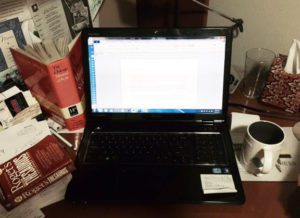Writing Through Writer’s Block
As a cub reporter right out of high school, my first newspaper editor threatened to tear up my notebook if I did not compose directly from my scribbled notes to the computer. No second drafts. Just get the story done by deadline. I soon came to love that fast-paced, adrenaline rush of getting a breaking story on the front page by the next morning’s paper.
Twenty-something years later when I finished my undergraduate degree at Vermont College, it was hard to break the habit of racing to the finish line. However, my first faculty mentor, Matthew Goodman, was as exacting as that newspaper editor. Except for one thing. He absolutely insisted that his students take the time to write about the process of writing itself.
At first I resisted – it seemed like a waste of time. Here’s how it worked: As I sat with a blank page (screen) in front of me, struggling how to carefully craft that perfect first sentence to convey a thought in the most elegant language possible, I had another page (computer document) nearby. On this second page, I wrote to Matthew what it was that I intended to write or what I struggled with as I wrote it.
Let’s say the essay was about carrying a gun in Alaska. I wrote to Matthew that I wanted to write about my ambivalence of carrying a firearm and how it changed over time. I wrote about how it bothered me that bears had teeth and claws and how moose had hooves to protect their young but I pretty much had nothing. So when my sons were little, I took a gun along on our adventures in Alaska’s backcountry, even though the weight of it felt ominous in my pack. The next thing I knew, I had written entire passages in my letter to Matthew – passages that I could lift, place and revise on the blank pages that still awaited that elusive, perfect first sentence.
It is like writing a letter to your best reader. “Let me tell you about …” In that letter you get all the literary throat clearing out of the way and then somewhere around paragraph three or maybe page four, you find the beginning of the piece. Writing about the writing can be away to break up a mental log-jam, beginning with describing “Here’s the problem …” or “I’m just not understanding …” It can also be a reflection on not knowing what to write next. “Just what am I supposed to do with these unruly characters anyway?”
The exercise is not the place for literary prowess – just a place to get the fingers moving and the mind in gear. Pour out the work’s frustrations and fears and challenges. This process led me to some unexpected surprises in my writing. Most of all it slowed me down to really think and dig deep.
Writing about writing was so fascinating that I continued on to Spalding University’s MFA in Writing program where this process was examined and refined even further. Several outstanding faculty mentors offered that same experience of having a “best reader” to be supportive while still demanding that I slow down and go deeper. To this day, my former mentors are the readers I imagine as I attempt to get unstuck in some writing challenge. I hardly need to send the email or letter – just the writing helps clear the way.
He doesn’t know it, but Matthew is often still my best audience when I write. He’s completely unlike me – male, Jewish, a city-dweller from New York – but he is curious and sympathetic and interested in my world. And he is exacting in a good way. He refuses sloppy story telling. He wants DETAILS. So I tell him about it and just by “listening,” he helps me find connections and complexities. And he helps me to lighten up. Have some fun.
[Along with Matthew and other fine mentors at Spalding, I’d like to thank Luke Wallin who recently worked, not as an imaginary reader, but as a real and fine editor while I worked on Our Perfect Wild: Ray and Barbara Bane’s Journeys in the Fate of the Wild North (University of Alaska Press, Spring 2016). This faculty mentor from Spalding offered exceptional support as we exchanged emails over the project. Many thanks Luke!]